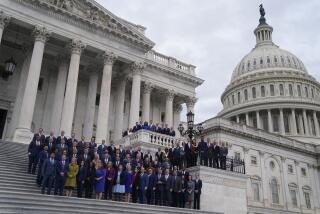BOOK REVIEW : Immigrants Share Rich, Varied Tales : VISIONS OF AMERICA: Personal Narratives From the Promised Land. Edited by Wesley Brown & Amy Ling . Persea Books $29.95, 369 pages
Few people recognize the name Carlos Bulosan these days, but in the 1940s the Philippines-born author published a number of books giving an immigrant’s view of the United States.
One of them was “America Is in the Heart: A Personal History,” and in an excerpt from that volume reprinted here, Bulosan describes his arrival in Seattle in 1930, near enslavement aboard an Alaska-bound fishing boat and the fortuitous discovery in Lompoc, a few months later, of his long-lost brother.
Bulosan, at this last encounter, had recently launched himself into “a world of strange intellectual adventures and self-fulfillment”; his brother, Amado, by contrast, has become a relatively prosperous bootlegger, buying illegal whiskey from an Italian and selling it to gambling dens in the Mexican district.
Amado assumes his brother will want to join this illicit business, but Bulosan refuses, seeing that Amado is “no longer the person I had known in Binalonan.” He leaves Lompoc for Los Angeles mourning Amado’s new way of life and saying to himself, “Please, God, don’t change me in America!”
Although these words are found in only the Bulosan excerpt, the idea it expresses--the hazards of assimilation--is apparent in many of the 30-odd essays collected in this volume.
The nonfiction counterpart of last year’s “Imagining America: Stories from the Promised Land,” “Visions of America” shows once again that the immigrant experience in the United States--broadly defined, as it should be--is extraordinarily rich, immeasurably varied and all but impervious to generalization.
Witness Barbara Grizzuti Harrison, finding in 1974 that the youth in her native Brooklyn regard America and Bensonhurst as virtually synonymous; and Anton Shammas, a Palestinian affiliated with the University of Michigan, concluding in 1991 that “Amerka” truly was the land of the free, having “enough room not only for newcomers but also for their portable homelands.”
Witness, too, Maxine Hong Kingston, born in Stockton yet growing up in a land where immigrant Chinese parents could say, “When you raise girls, you’re raising children for strangers”; and Kim Yong Ik, helped by an Iowa butcher in his early writing career in the 1950s who charged him only 20 cents for sandwich meat no matter how much Kim ordered.
Inspiring and exploitive, parochial yet broad-minded, tolerant even of intolerance, the United States is all these things and more, depending on personal experience and the tenor of the times.
Wesley Brown and Amy Ling, who also edited “Imagining America,” have selected for “Visions of America” an exemplary range of narratives. East Indian and Eurasian, East European and Caribbean, American Indian and Hispanic--everyone seems to be here, the editors recognizing the need to be inclusive.
Not “representative,” mind: One major strength of this book lies in the fact that these essays, taken together, demonstrate the absurdity of attempting to single out any individual’s view as “representative” of any minority or, for that matter, any majority.
None of these writers is the self-appointed spokesman for a group; most of these essays are personal, sometimes painfully so, as each writer attempts to come to terms with his or her identity, with his or her relationship to America.
Although a few of the stories included here, like Harrison’s, deal with conflict between cultures or races, many more describe the more subtle, more ambiguous conflicts within an immigrant group.
Bharati Mukherjee, upon arriving in the United States, has to learn to distinguish herself from Doris Day: she left Calcutta for college in America because her father adored MGM musicals and regarded Day, an “empowered woman” to his mind, as an appropriate role model.
Monica Sone was born in Seattle, but during World War II she suddenly became a mongrel: American enough to argue with her parents over Japanese aggression in Manchuria, Japanese enough to be interned as an alien. The question always hovers in the background: Is America an idea into which I must fit, or will America, a nation of immigrants, allow my views to become part of the cultural fabric?
Nowhere is the question better illustrated than in the excerpt from “Lost in Translation,” in which Krakow, Poland-born Eva Hoffman writes of her “immigrant rage” while a Harvard student in the early 1970s.
“My misfortune,” she writes, “is to see the grid of general assumptions drawn over particular personalities,” to sense “the tyranny of subliminal conventions,” to know, in short, that those who appear to represent the standard, majority culture never need justify their existence, their beliefs, their traditions, whatever inherent shortcomings may persist.
“Visions of America” is a fine anthology, one that clearly shows that the strength of the United States is directly linked to its ability to accept, even encourage and sponsor, diverse views.
More to Read
Sign up for our Book Club newsletter
Get the latest news, events and more from the Los Angeles Times Book Club, and help us get L.A. reading and talking.
You may occasionally receive promotional content from the Los Angeles Times.






